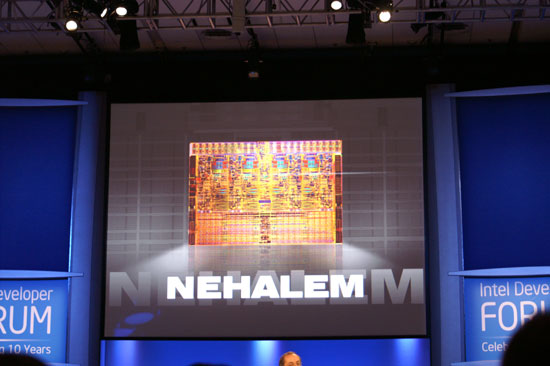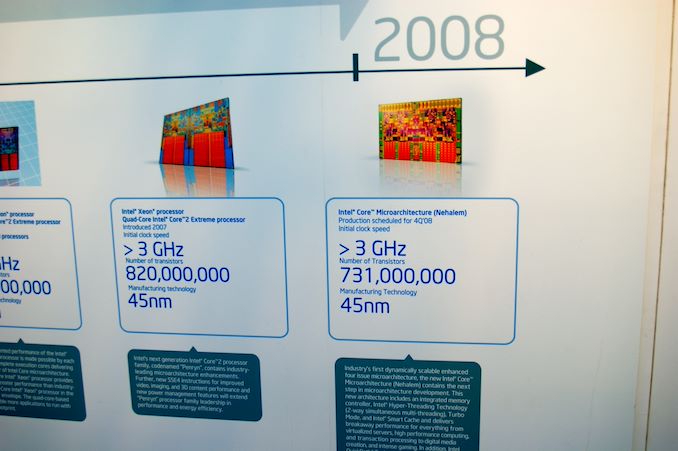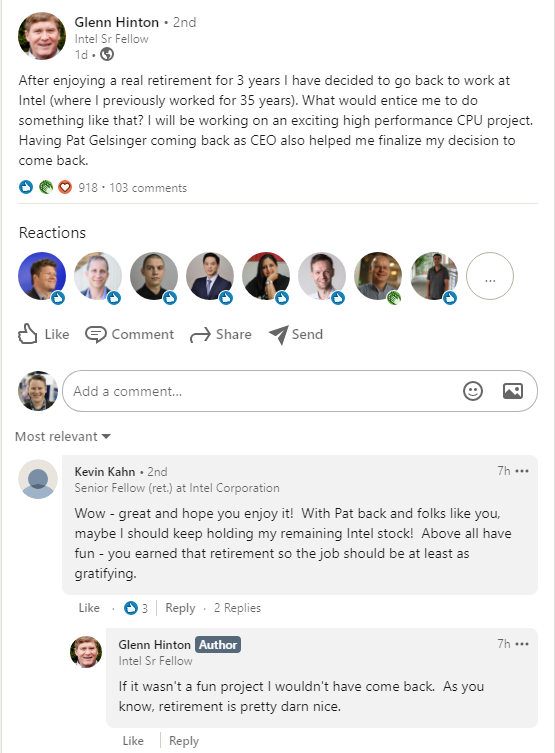New Intel CEO Making Waves: Rehiring Retired CPU Architects
by Dr. Ian Cutress on January 21, 2021 5:05 AM EST- Posted in
- CPUs
- Intel
- Nehalem
- Pat Gelsinger

We’re following the state of play with Intel’s new CEO, Pat Gelsinger, very closely. Even as an Intel employee for 30 years, rising to the rank of CTO, then taking 12 years away from the company, his arrival has been met with praise across the spectrum given his background and previous successes. He isn’t even set to take his new role until February 15th, however his return is already causing a stir with Intel’s current R&D teams.
News in the last 24 hours, based on public statements, states that former Intel Senior Fellow Glenn Hinton, who lists being the lead architect of Intel’s Nehalem CPU core in his list of achievements, is coming out of retirement to re-join the company. (The other lead architect of Nehalem are Ronak Singhal and Per Hammerlund - Ronak is still at Intel, working on next-gen processors, while Per has been at Apple for five years.)
Hinton is an old Intel hand, with 35 years of experience, leading microarchitecture development of Pentium 4, one of three senior architects of Intel’s P6 processor design (which led to Pentium Pro, P2, P3), and ultimately one of the drivers to Intel’s Core architecture which is still at the forefront of Intel’s portfolio today. He also a lead microarchitect for Intel’s i960 CA, the world’s first super-scalar microprocessor. Hinton holds more than 90+ patents from 8 CPU designs from his endeavors. Hinton spent another 10+ years at Intel after Nehalem, but Nehalem is listed in many places as his primary public achievement at Intel.
On his social media posts, Hinton states that he will be working on ‘an exciting high performance CPU project’. In the associated comments also states that ‘if it wasn’t a fun project I wouldn’t have come back – as you know, retirement is pretty darn nice’. Glenn also discloses that he has been pondering the move since November, and Gelsinger’s re-hiring helped finalize that decision. His peers also opine that Glenn is probably not the only ex-Intel architect that might be heading back to the company. We know a few architects and specialists that have left Intel in recent years to join Intel's competitors, such as AMD and Apple.
There are a few key things to note here worth considering.
First is that coming out of retirement for a big CPU project isn’t a trivial thing, especially for an Intel Senior Fellow. Given Intel’s successes, one would assume that the financial situation is not the main driver here, but the opportunity to work on something new and exciting. Plus, these sorts of projects take years of development, at least three, and thus Glenn is signing on for a long term despite already having left to retire.
Second point is reiterating that last line – whatever project Glenn is working on, it will be a long term project. Assuming that Glenn is talking about a fresh project within Intel’s R&D ecosystem, it will be 3-5 years before we see the fruits of the labor, which also means creating a design aimed at what could be a variety of process node technologies. Glenn’s expertise as lead architect is quite likely applicable for any stage of an Intel R&D design window, but is perhaps best served from the initial stages. The way Glenn seems to put it, this might be a black-ops style design. It also doesn't specify if this is x86, leaving that door open to speculation.
Third here is to recognize that Intel has a number of processor design teams in-house and despite the manufacturing process delays, they haven’t been idle. We’ve been seeing refresh after refresh of Skylake lead Intel's portfolio, and while the first iterations of the 10nm Cove cores come to market, Intel’s internal design teams would have been working on the next generation, and the next generation after that – the only barrier to deployment would have been manufacturing. I recall a discussion with Intel’s engineers around Kaby Lake time, when I asked about Intel’s progress on IPC – I requested a +10% gen-on-gen increase over the next two years at the time, and I was told that those designs were done and baked – they were already working on the ones beyond that. Those designs were likely Ice/Tiger Lake, and so Intel’s core design teams have been surging ahead despite manufacturing issues, and I wonder if there’s now a 3-4 year (or more) delay on some of these designs. If Glenn is hinting at a project beyond that, then we could be waiting even longer.
Fourth and finally, one of the critical elements listed by a number of analysts on the announcement of Gelsinger’s arrival was that he wouldn’t have much of an effect until 3+ years down the line, because of how product cycles work. I rejected that premise outright, stating that Pat can come in and change elements of Intel’s culture immediately, and could sit in the room with the relevant engineers and discuss product design on a level that Bob Swan cannot. Pat has the opportunity to arrange the leadership structure and instill new confidence in those structures, some of which may have caused key architects in the past to retire, instead of build on exciting projects.
As we can see, Pat is already having an effect before his name is even on the door at HQ.
Today is also Intel’s end-of-year financial disclosure, at 5pm ET. We are expecting Intel’s current CEO, Bob Swan, to talk through what looks to be another record breaking year of revenue, and likely the state of play for Intel's own 7nm process node technologies. That last point is somewhat thrown into doubt given the new CEO announcement and if Gelsinger is on the call. It is unknown if Gelsinger will participate.
Related Reading
- Intel Appoints Pat Gelsinger as New CEO, From Feb 15th
- An Interview with Intel CEO Bob Swan: Roundtable Q&A on Fabs and Future
- Robert Swan Named CEO of Intel













112 Comments
View All Comments
JayNor - Friday, January 22, 2021 - link
"Intel products that no one can get their hands on..."Intel stated there are already 150 TGL designs shipping, so they don't seem to be having a current capacity problem with their 10SF process.
Aekitct - Thursday, January 21, 2021 - link
Architect is a licensed professional that holds a bachelor's degree in Architecture. Please avoid appropriating real degrees with high regard for namesakes of lame computer science degree.grant3 - Thursday, January 21, 2021 - link
Sorry to inform you: licensing groups do not get to hold the entire world hostage for the definitions of words.Sure, a person may require a license to legally market his services as a "Building architect" to the public, in most jurisdictions. But an expiring license doesn't magically mean that person is no longer an "architect." It just means he's legally restricted from advertising or certifying work that requires that license.
Furthermore, a "processor architect" never needs to be licensed to design processor architectures. Glenn Hinton isn't an architect because of a "lame computer science degree". He's an architect because he not only performed the work of architecting processors, but became a recognized world leader in that field.
If you or anyone else can't handle someone legitimately being called an architect because you're upset that it's "appropriating real degrees with high regard" then you're in for a lifetime of disappointment outside the ivory towers of your fellow degree snobs.
mode_13h - Saturday, January 23, 2021 - link
Exactly. Thanks for that.I can legally advertise myself as a software engineer, precisely because there's no certification required in my state for that job title. Same for computer architect.
Lord of the Bored - Friday, January 22, 2021 - link
Architects design architecture.CPU architecture is an accepted term.
Therefore, CPU architects exist, regardless of what building architects want to believe.
GeoffreyA - Friday, January 22, 2021 - link
What's more, I wonder what their building architecture software runs on. Fresh air, I suppose.WaltC - Thursday, January 21, 2021 - link
I hope for Intel's sake they do not try and resurrect Itanium. Bringing old hands out of retirement is certainly a mark of desperation. Let's hope they have some new ideas--finally--now that AMD has once again started a fire underneath the Intel derrière...;) Rehashing 14nm ancient architectures won't carry them very long from nown, however. Monopolistic thinking and management put Intel where it is today in reference to AMD. It's difficult to teach old dogs new tricks--we'll see how Intel handles being second fiddle. I have zero sympathy for Intel--none at all. OTOH, I have great admiration for AMD--a company of engineers versus the Intel saga of empty suits and bean counters perpetually running the show. The days of having no competitors because Intel ran them out of business are behind Intel now and will never come again--now we'll see what stuff the company is made of--if anything.grant3 - Thursday, January 21, 2021 - link
Worrying about "resurrecting Itanium" is an oddly specific fear. Why would you even suspect that's a topic of debate at Intel?Lord of the Bored - Friday, January 22, 2021 - link
I believe the argument is "lol old people made old processorz like itanium".And they don't actually register the Pentium 4 itself as a fiasco, so they reached for it's dearly-departed sister chip.
Makste - Friday, January 22, 2021 - link
Your fear of the itanium resurrection feels more than authentic 🤔